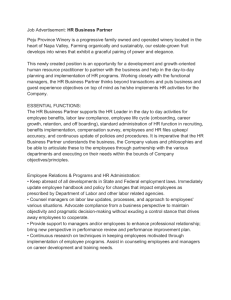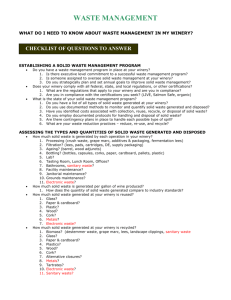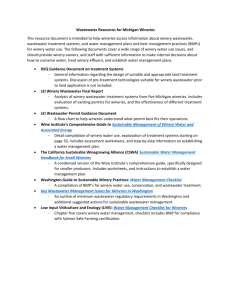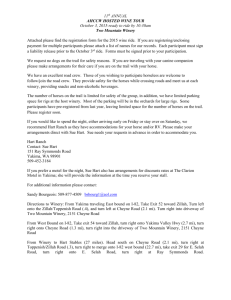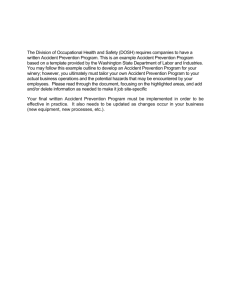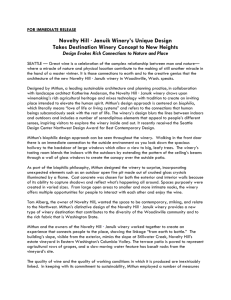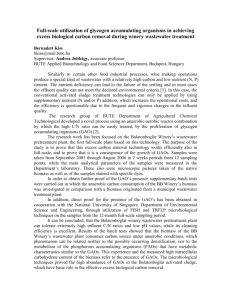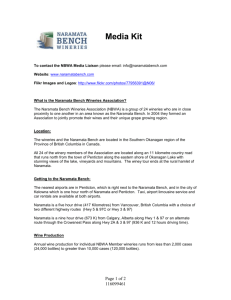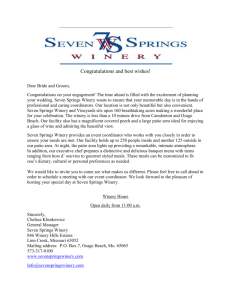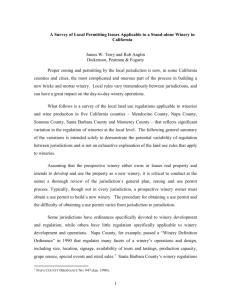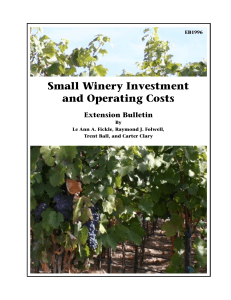Winery Safety Training Guidelines
advertisement
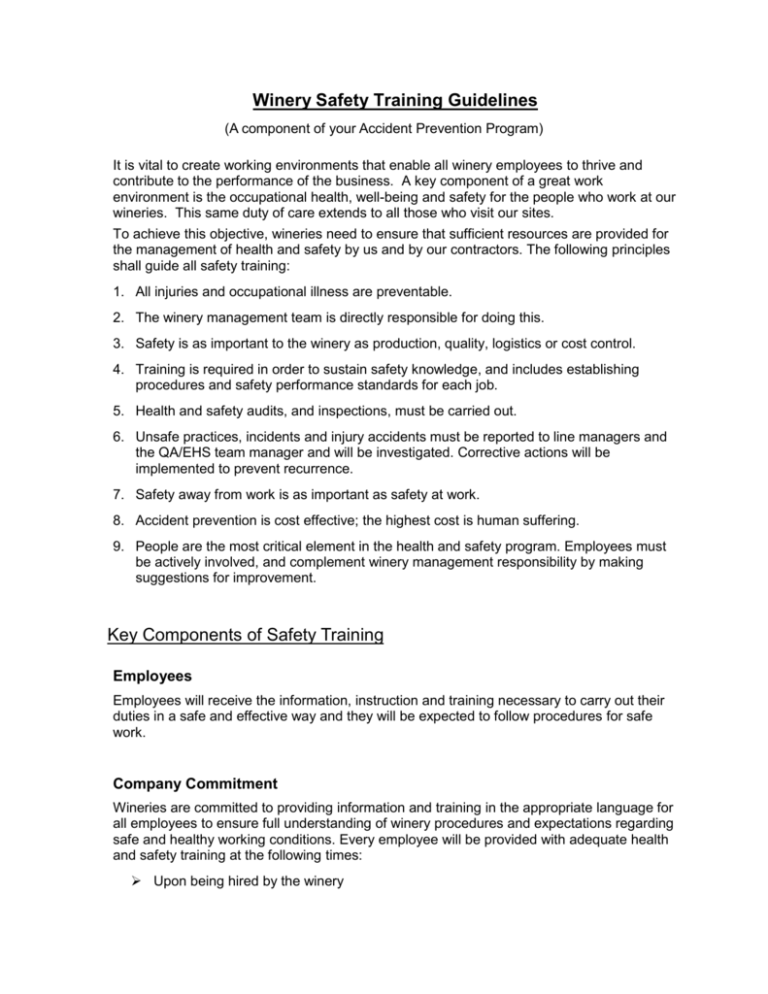
Winery Safety Training Guidelines (A component of your Accident Prevention Program) It is vital to create working environments that enable all winery employees to thrive and contribute to the performance of the business. A key component of a great work environment is the occupational health, well-being and safety for the people who work at our wineries. This same duty of care extends to all those who visit our sites. To achieve this objective, wineries need to ensure that sufficient resources are provided for the management of health and safety by us and by our contractors. The following principles shall guide all safety training: 1. All injuries and occupational illness are preventable. 2. The winery management team is directly responsible for doing this. 3. Safety is as important to the winery as production, quality, logistics or cost control. 4. Training is required in order to sustain safety knowledge, and includes establishing procedures and safety performance standards for each job. 5. Health and safety audits, and inspections, must be carried out. 6. Unsafe practices, incidents and injury accidents must be reported to line managers and the QA/EHS team manager and will be investigated. Corrective actions will be implemented to prevent recurrence. 7. Safety away from work is as important as safety at work. 8. Accident prevention is cost effective; the highest cost is human suffering. 9. People are the most critical element in the health and safety program. Employees must be actively involved, and complement winery management responsibility by making suggestions for improvement. Key Components of Safety Training Employees Employees will receive the information, instruction and training necessary to carry out their duties in a safe and effective way and they will be expected to follow procedures for safe work. Company Commitment Wineries are committed to providing information and training in the appropriate language for all employees to ensure full understanding of winery procedures and expectations regarding safe and healthy working conditions. Every employee will be provided with adequate health and safety training at the following times: Upon being hired by the winery Upon being exposed to new or increased risks because of being transferred or given new responsibilities within the winery Upon being exposed to new or increased risk because of the introduction of new work equipment, new technology, or a new system of work into the workplace Winery training Competent persons must carry out training in the winery. These are the primary types of health and safety training that must be carried out: Occupational Health and Safety policy awareness New employee orientation training General safety awareness training Other health and safety training on specific subjects (i.e., confined space, fall protection, hot work, forklift, emergency evacuation, etc.) Training records will be maintained by each site safety coordinator and refresher classes will be offered on a periodic basis depending on regulatory requirements and site needs. OHS Policies/Responsibilities/Procedures shall be reviewed and revised annually by the site safety coordinator. Safety and Health Communications A method will be implemented at the winery for communicating safety and health issues to all employees. Two-way communication is encouraged so employees can inform management of unsafe acts/conditions or hazards without fear of reprisal. Communications shall: Allow employees an opportunity to voice their concern about general safety, unsafe acts, conditions or processes Provide essential and mandatory safety and health training and document attendance. Distribute safety information to all employees and retain an acknowledgement receipt Utilize safety posters, bulletins, newsletters or similar publications Hold regular department safety meetings and safety committee meetings Communication must be readily understandable by all employees and in the appropriate language. Monthly Safety Training Meetings All winery employees, including the office and VC staff, will attend monthly safety training meetings. The training will be coordinated by the OHS coordinator, or designated employee. Each training session will cover specific topics required by the OSHA regulations. It is the responsibility of the managers and supervisors to give any make-up training that is missed in their department. Monthly Training Topics Suggested for Wineries. The following safety topics are to be covered on an annual basis: Month January Topics Ergonomics Lifting February IIPP/Safe Work Practices Job specific training March Hazard Communication/MSDS PPE Training April Fire Extinguishers Emergency Action Plans May Pollution Prevention/Storm water Environmental Training June Forklift Lock-out/Tag-out July Respiratory Protection Spirometry August Confined Space Fall Protection September Crush Safety – General topics October LP Gas Safety November Audiogram Hearing Conservation December FA/CPR Bloodborne Pathogens Training does not specifically have to occur in the above order as long training on all of the topics above is covered on an annual basis. Vineyard operations also implement monthly training. Topics are dependent on the chemicals used in the vineyards at any given time, and the activity (i.e., pruning, harvest, suckering, etc.). New Employee Orientation All new employees shall be given a tour of the facility and informed of the locations of safety equipment and designated evacuation locations and routes. The OHS Coordinator or designee will coordinate and/or deliver all new employee orientation training. Postings From time to time, specific safety rules and procedures will be posted on facility bulletin boards. Training Training requirements should be designed to instruct each employee on general safety procedures as well as on safety procedures specific to the employee’s job. These training requirements are described in greater detail below. Enforcement of the Safety Program It is recognized that there may be degrees of safety violations, but generally, such violations are of a serious nature because of danger to the employee or to other employees, or danger to the property of the employer. Discipline for violations of OSHA or published safety rules will be imposed on a case-by-case basis, up to and including discharge. Safety and Health Training Awareness of potential health and safety hazards, as well as knowledge of how to control such hazards, is critical to maintaining a safe and healthful work environment and preventing injuries, illnesses, and accidents in the workplace. The winery is committed to instructing all employees in safe and healthful work practices. To achieve this goal, the winery will provide training to each employee with regard to general safety procedures and with regard to any hazards or safety procedures specific to that employee’s work assignment. When Training Will Occur Upon hiring. Whenever an employee is given a new job assignment for which training has not previously been provided. Whenever new substances, processes, procedures or equipment, which represent a new hazard, are introduced into the workplace. Whenever the winery is made aware of a new or previously unrecognized hazard. Whenever the Risk Manager, Department Manager, or Supervisor believe that additional training is necessary. Training of Supervisors and Department Managers Supervisors and Department Managers will be trained by attending appropriate safety and health seminars, and through memorandums and procedures issued by the Risk Management Group and other departments. Documentation of Training All training documentation will be retained for a minimum of five (5) years. Copies of all training documents will be forwarded to the winery safety department so that training can be appropriately tracked.
